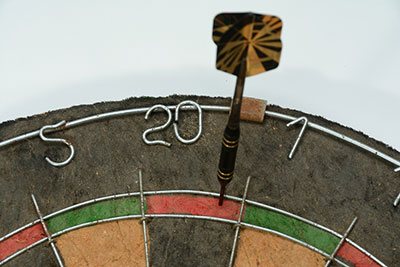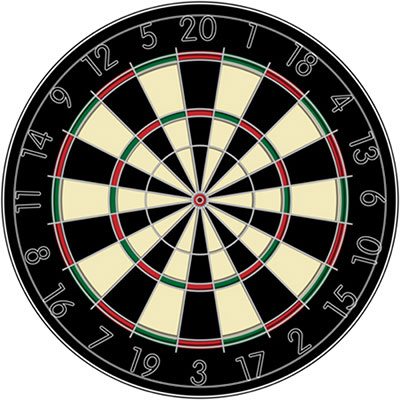Darts has gained worldwide popularity over the years. Nowadays, you can seldom walk into a bar without a dart board hung up on the wall. In no time, you'll see darts flying, people having fun, shouting, and writing numbers to keep the game's score.
But, while just anyone can throw darts into a board and goof around, cricket darts requires a bit more professionalism.
The game itself is not at all challenging, but you need to learn a couple of ground rules to know what part of the board you're aiming at and how to keep the score.
In the article below, we have deconstructed the game of cricket darts to the most straightforward rules, and once you read it, you'll learn how to play cricket darts like a professional! Also, we included one bonus game, so you get the best out of your dart board!
Let's get to business, shall we?
More...
What is Cricket Darts?

Cricket, or Horse and Carriage as it is called in Britain, is a darts game played on the standard dart board with double and triple rings. It is most frequently played between two players or two teams of players, and every player takes its turn in throwing.
The numbers used in Cricket Darts are numbers from 15 to 20 and a bullseye, and the aim of cricket darts is to close out the numbers first and have a higher score at the end.
There are many variations of cricket darts, depending on the region where it is played. For example, Bowlers and Batters is known as English cricket, Tactics as well, Newfie Cricket (Faldo) is played in Canada, while West Riding is a Yorkshire variation.
What we will depict in this article is a standard cricket darts played worldwide.
What You Will Need for This Game?
To play cricket darts, you will need to prepare:
How to Play Cricket Darts Like a Professional?
1. The Aim of the Game
In cricket darts, the aim is to have a higher score than the other team once all the numbers from 15-20 and the bullseye have been closed out.
2. The Rules of the Game

Every player gets to throw three darts at the dart board, trying to hit the numbers between 15-20 or a bullseye.
For a number to be closed out, it needs to be hit three times. If your team closes out a number before the other team, you get the points for every additional hit on the closed out number until the other team closes it out too. Once the number is closed out by both sides, it is no longer in play.
If you hit the double ring of a number, that counts for two strikes, and the triple ring counts for three strikes. So if you hit a triple ring of a number right away, you closed it out.
When it comes to the bullseye, the outer ring counts for one, and the inner ring for two.
If you hit any number other than 15-20, nothing happens.
3. How Does The Game End?
The team that closes the board out first and has a higher or equal score wins the game.
4. How to Keep The Score?

Take what you had prepared for the scorekeeping and draw three equal columns. In the first column, write team one; in the third write, team two.
In the middle column, write numbers from fifteen to twenty and a bullseye in a vertical line.
Now, your scoreboard should look something like this:
The first time your team hits a number, you draw a "/" next to it; the second time you hit it, add another "\" to form an "X", and once the number is fully closed out, you draw a circle around the X.
Once the number is closed out, you start gaining points for every following hit until the other team closes it out.
The number of points equals the number you hit, so If you hit fifteen, for example, you get fifteen points. If you hit the double circle, you get 30 points, and triple ring, you get 45 points.
When it comes to the bullseye, the outer circle brings 25 points to the team, while the inner circle gets 50 points.
Here is one useful video that may help you better understand the game and visualize how everything is supposed to look.
Bonus Game: Scram!
According to some darts players, scram is considered a variation of darts cricket, but it has completely different rules. This game is played in only two rounds and does not last as long as darts crickets.
The usual number of players involved in this game is two.
What Do I Need for This Game?
For this game you need:
What Are the General Rules of the Game?

Now, in this game, unlike darts cricket, all the numbers on the board are used, along with the bullseye.
In this game, there are two roles for the players. One character is a blocker, the other one a scorer. Both players will be alternating between positions during the game.
At the start of the scram, each player throws a dart at the board, and the one whose dart lands closer to the bullseye gets to be the blocker.
Now in the first round, a blocker throws three darts, and whatever number is hit becomes closed out. The goal of a blocker is to close out the numbers that bring a higher score.
The scorer then throws three darts, aiming only at the numbers that are not closed out. He gets the score for the three numbers that are hit. Naturally, the aim is to get as high a score as possible.
Once the scorer is done, the first round ends.
In the second round, the players change roles, and now the blocker from the first round becomes a scorer in the second.
At the beginning of the next part of the game, all the numbers count once again. Now the blocker throws three darts and closes out three numbers for the scorer. Then, the scorer throws three darts aiming only at the numbers that are not closed out and proportionally get a specific score.
How to Keep the Score?
In the game of scram, all the numbers are used. Contrary to darts cricket, one hit a number closes it out.
The score is proportional to the number you hit. If you hit fifteen, you get fifteen points; if you hit twenty, you get twenty points.
Just like in cricket darts, if you hit a double ring, you get double the score of your number, and if you hit a triple ring, you get three times the score of your number. For example, a double ring for twenty has a score value of forty, while a triple ring for twenty has a score value of sixty.
When it comes to the bullseye, the outer rings have a score value of twenty-five, while the inner circle brings a player fifty points.

How Does the Game End?
The game ends after the second round when both players have been the blockers and scorers once. The player who has a higher score after the second round is the winner. Naturally, you can play more than one game since two rounds won't last for more than 10-15 minutes.
Here is one useful video that may help you understand how to play scram.
There are numerous other dart games you can play with darts.
In fact, there are countless different variations of darts cricket solely, so don't be afraid to try them all out since the beauty of this sport is in the versatility and practice that brings you to precision and mastery!
Final Thoughts
And that was all for the cricket darts. As you can see, it is not at all complicated; you just need to follow the rules and try to be as precise as possible. Don't hesitate to include as many friends as you want in the game since it will only make it more exciting and engaging for everyone.
There are many variations of dart cricket, especially in different parts of the world, so don't get confused if you're in the bar, and people are playing it in a completely different way then described above. What we described here is the standard cricket darts with commonly used rules and scoring system.
If you're playing it for fun only, feel free to adapt the game to your situation any way you want, it's about having fun after all.
